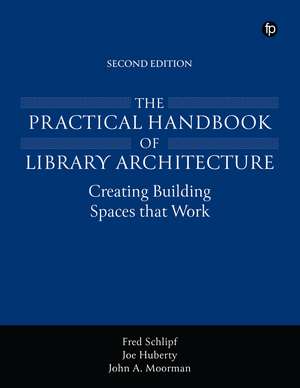The Practical Handbook of Library Architecture
Autor Fred Schlipf, Joe Huberty, John A. Moormanen Limba Engleză Paperback – mar 2024
- provides nuts-and-bolts guidance on the entire process of planning, design, and construction, including "snappy rules" summarizing each chapter;
- covers new construction, remodeling and expanding of existing buildings, and conversion of non-library spaces to libraries;
- explains how library buildings actually function as objects, and how that applies to library design;
- reviews typical design problems of existing libraries, and advises libraries on how to avoid creating dysfunctional buildings and spaces;
- shows how to collaborate productively with planners, architects, and contractors;
- discusses the technical needs of basic library spaces, including collection storage, user seating, meeting and conference rooms, craft rooms, study areas, service desks, restrooms, and staff workspaces; and
- includes careful consideration of technical requirements relating to lighting, electrical systems, security systems, elevators, staircases, and other areas.
Preț: 984.64 lei
Preț vechi: 1278.75 lei
-23% Nou
Puncte Express: 1477
Preț estimativ în valută:
188.41€ • 205.30$ • 158.76£
188.41€ • 205.30$ • 158.76£
Carte disponibilă
Livrare economică 03-17 aprilie
Livrare express 19-25 martie pentru 71.81 lei
Preluare comenzi: 021 569.72.76
Specificații
ISBN-13: 9781783307173
ISBN-10: 178330717X
Pagini: 600
Dimensiuni: 283 x 219 x 45 mm
Greutate: 1.95 kg
Ediția:1
Editura: Facet Publishing
Colecția Facet Publishing
ISBN-10: 178330717X
Pagini: 600
Dimensiuni: 283 x 219 x 45 mm
Greutate: 1.95 kg
Ediția:1
Editura: Facet Publishing
Colecția Facet Publishing
Public țintă
Postgraduate, Professional Practice & Development, and Professional ReferenceCuprins
Part I Introduction 1. Introduction 2. More Than Two Hundred Snappy Rules for Good and Evil in Library Architecture Part II About Library Buildings 3. The Library Construction Process 4. Basic Configuration of Library Spaces 5. Evaluating Library Buildings by Walking Around 6. Dysfunctional Designs 7. Converting Non-Library Spaces to Public Libraries Part III Basic Steps 8. Programming 9. Design 10. Site Selection 11. Zoning, Covenants, and Codes 12. Construction 13. Remodeling and Expanding Library Buildings 14. Building Costs 15. Funding 16. User Seating 17. Collection Storage 18. Public Service Desks 19. Program and Study Rooms 20. Display and Exhibit Areas 21. Restrooms 22. Staff Workrooms 23. Staff Facilities 24. Storerooms Part VI Technical Issues 25. Lighting 26. Elevators, Staircases, Railings, and Ramps 27. Electrical Systems 28. Heating, Ventilating, and Air Conditioning Systems 29. Plumbing Systems 30. Security 31. Walls, Floors, and Ceilings
Notă biografică
Fred Schlipf has been hanging out in library buildings since the early 1940s (at about the age of four, he turned out all the lights in the Detroit Lakes (Minnesota) Public Library one evening—a happy moment that is still both bright and dark in his memory), and has been working for libraries and teaching about libraries and consulting on library buildings since he was 17. He's been a library school faculty member for over 50 years, and he spent nearly 33 years as director of The Urbana Free Library, the public library of Urbana, Illinois (just down the street from the University of Illinois). He's done formal building consulting for between 150 and 200 libraries and quick consulting for many more, and he visits library buildings everywhere he goes. He has a BA from Carleton College and an MA and PhD from the Graduate Library School of the University of Chicago. He has served on dozens of committees and task forces of the American Library Association, Illinois State Library, Illinois Library Association, local library groups in Illinois, and the Illuminating Engineering Society of North America. He was Illinois Librarian of the Year in 2000.
John A. Moorman has worked as director of five public libraries and a multi-type library system, most recently the Decatur (Illinois) Public Library and the Williamsburg (Virginia) Regional Library. He has a PhD from the University of Illinois library school. He has been active in state and national library associations. When not working with buildings, he developed a specialty in legislative matters, served as a registered lobbyist, and chaired legislative-related committees for the Illinois and Virginia Library Associations. He is a past president of the Virginia Library Association and a lifelong elected honorary member of that association. Within the American Library Association (ALA) he served on the Public Library Association's Board of Directors, the ALA Council, and the ALA Executive Board, as well as serving on, and chairing, many committees and task forces.
John A. Moorman has worked as director of five public libraries and a multi-type library system, most recently the Decatur (Illinois) Public Library and the Williamsburg (Virginia) Regional Library. He has a PhD from the University of Illinois library school. He has been active in state and national library associations. When not working with buildings, he developed a specialty in legislative matters, served as a registered lobbyist, and chaired legislative-related committees for the Illinois and Virginia Library Associations. He is a past president of the Virginia Library Association and a lifelong elected honorary member of that association. Within the American Library Association (ALA) he served on the Public Library Association's Board of Directors, the ALA Council, and the ALA Executive Board, as well as serving on, and chairing, many committees and task forces.
Descriere
Distilling hard fought wisdom gleaned from hundreds of successful library construction projects they've supervised or coordinated, the authors present this definitive resource on library architecture.
